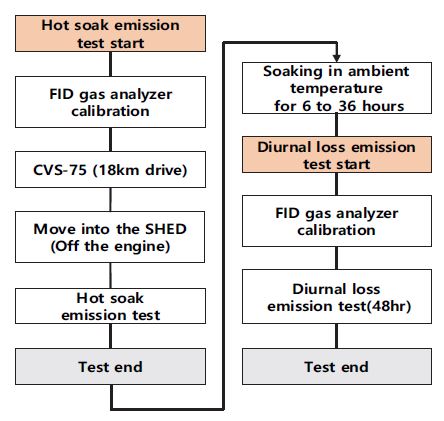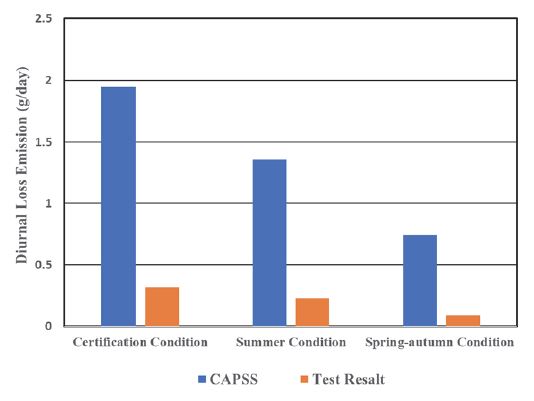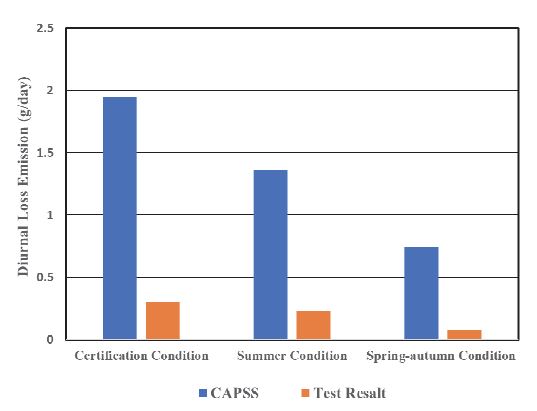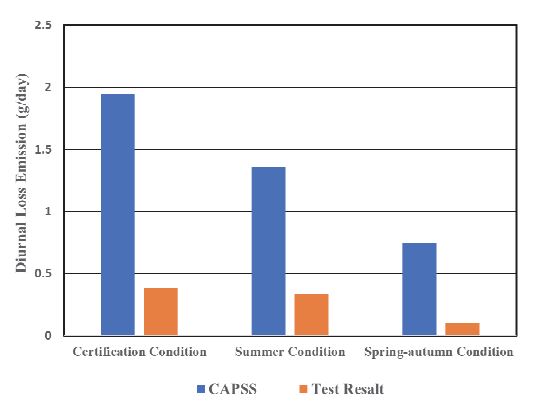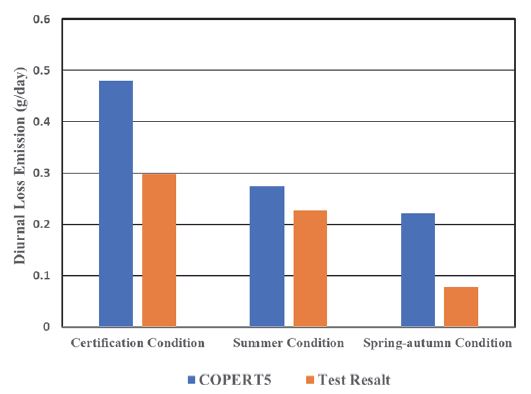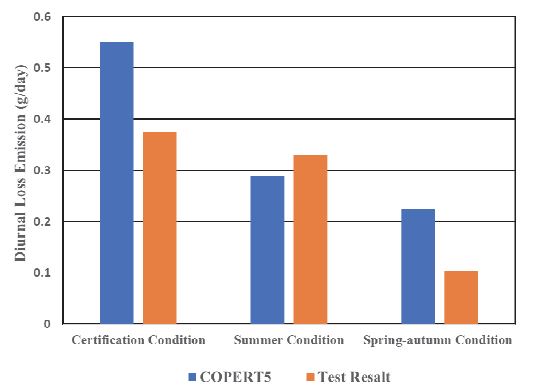
휘발유 승용차의 주간증발가스 시험을 통한 CAPSS 주간증발가스 산정식 평가 및 개선
Copyright Ⓒ 2022 KSAE / 205-03
This is an Open-Access article distributed under the terms of the Creative Commons Attribution Non-Commercial License(http://creativecommons.org/licenses/by-nc/3.0) which permits unrestricted non-commercial use, distribution, and reproduction in any medium provided the original work is properly cited.
Abstract
In vehicles that use gasoline as fuel, hydrocarbons generated in the form of evaporative gases are harmful to the human body and cause ozone generation. In order to reduce evaporative emissions, Korea has been steadily strengthening evaporative emission regulations and calculating the total amount of evaporative gases generated in gasoline cars through the Clean Air Policy Support System(CAPSS). However, the current CAPSS calculation formula has a limitation since it does not reflect regulatory strengthening and technological development. Therefore, this study intends to present the necessity and direction of improvement of the CAPSS evaporation gas calculation formula. The amount of evaporation gas emissions during parking(Diurnal loss test) of three gasoline vehicles is measured by SHED. The test results are evaluated by comparing them with the domestic CAPSS formula. The direction of improvement of the CAPSS formula was also presented.
Keywords:
Evaporation emission, SHED, Diurnal loss, CAPSS, COPERT5키워드:
증발가스, 가변온도밀폐실, 주간증발가스, 대기정책 지원시스템, 유럽 도로 이동오염원 배출 계산 프로그램1. 서 론
휘발유를 연료로 사용하는 자동차에서 증발가스 형태로 발생하는 탄화수소는 인체에 유해하며, 광화학스모그나 오존생성의 원인이 된다.1) 증발가스는 차량 주행 중 및 주차 중에 발생하며 국내에선 이러한 증발량을 CAPSS를 통하여 총 배출량을 산정한다.2,3) 또한 증발가스 저감을 위하여 Table 1과 같이 제작자동차 배출허용기준을 강화해왔다.4) 하지만 CAPSS 증발가스 산정식은 비교적 오래된 산정방식 및 매개변수를 사용하여 현재까지 꾸준히 강화되어온 배출허용기준을 적절하게 반영하지 못하는 한계를 가지고 있다.
본 연구는 CAPSS의 증발가스 산정식 중 비중이 가장 큰 주간증발배출 산정식의 평가 및 개선 필요성을 제시하고자 한다. 평가를 위한 비교 데이터는 주간증발배출시험을 통해 얻었으며, 휘발유를 연료로 사용하는 차량 3종으로 시험을 진행하였다. 본 연구는 시험 결과를 바탕으로 CAPSS 산정식을 평가하고 개선방안을 제시한다.
2. 증발가스 산정방식
2.1 CAPSS 증발가스 산정식
국내에선 대기정책지원시스템(CAPSS)을 이용하여 여러 오염원에서 발생하는 대기오염물질의 배출량을 산정한다.5) 본 연구에선 도로이동오염원 중 VOC 배출량을 중점적으로 다룬다. 휘발유 차량의 증발가스배출량을 산정하는 방식은 아래 식 (1)과 같다.
| (1) |
여기서, Eeυa,υoc,j : 연간 증발 배출량(g)
aj : 차종 j의 휘발유 사용차량 등록대수(대)
ed : 주간증발배출량(g/day)
Sc+Sfi : Hot soak 배출량(g/day)
R : Runnig loss 배출량(g/day)
CAPSS 증발배출량 산정식은 크게 주간증발배출량, Hot soak 배출량, Running loss 배출량으로 나뉜다. 그 중 Hot soak 배출량은 Fuel injection 방식 및 Carbon canister가 장착된 차량의 경우 거의 배출되지 않아 CAPSS 산정식에선 0의 값으로 계산된다.4) 또 다른 구성요소인 Running loss의 경우 실제 배출량이 크지 않으며 CAPSS 산정식에선 주간증발배출량의 10 %수준으로 산정된다.6) 따라서 본 연구에선 주간증발배출량을 주로 다루며, CAPSS 주간증발배출량 산정식은 아래 식 (2)와 같다.
| (2) |
여기서, ed,j : 주간증발배출량(g/day)
RVP : 연료증기압(kPa)
Ta,min : 월중 평균 최저기온(g/day)
Ta,rise : 월중 평균 일교차(g/day)
CAPSS의 주간증발배출량 산정식은 월별 평균 기온값을 이용하며 증기압은 82 kPa로 고정된 값을 사용한다. CAPSS 증발배출량 산정식은 2013년 발간된 「국가 대기오염물질 배출량 산정방법 편람 (Ⅲ)」 이후로 큰 변화 없이 현재까지 사용되고 있어 꾸준히 강화된 제작차 배출허용기준을 적절히 반영시키지 못하고 있다.
2.2 COPERT5 증발가스 산정방식
국내 CAPSS 중발가스산정식은 유럽 도로운송수단 배출량 계산 프로그램인 COPERT의 세 번째 버전인 COPERT3를 기반으로 제작되었다. 현재 COPERT는 다섯 번째 버전인 COPERT5까지 업데이트 되었다. COPERT5 증발가스 산정식은 확보된 데이터에 따라 Tier1, 2, 3 방식 중 하나를 선택하여 계산이 가능하다. 식 (3)은 COPERT5 Tier3 증발가스 산정식이다.7)
| (3) |
여기서, Eυoc : 연간 증발 배출량(g)
Ds : 계절별 일수(day)
Nj : 차종 j의 등록대수(g/day)
s : 계절구분
j : 차종구분
HSj : Hot soak 배출량(g/day)
ed,j : 주간 증발 배출량(g/day)
RLj : Runnig loss 배출량(g/day)
식 (3) 중에서 주간증발 배출량(ed,j)을 산정하는 식은 아래 식 (4)와 같다.
| (4) |
여기서, ed,j : 주간증발배출량(g/day)
fk : 주차기간 분포비율
k : 주차기간구분
mbreak : 캐니스터 통과 배출량(g)
Tmin,k : 주차 중 연료탱크 최저온도(oC)
Tmax,k : 주차 중 연료탱크 최고온도(oC)
mrest : Permeation 배출량(g)
COPERT5 방식은 주간증발배출량은 크게 캐니스터를 통과한 배출량인 mbreak값과, 연료라인 등에서 발생하는 Permeation 배출량인 mrest으로 나눠진다. mbreak값 계산에는 여러 온도 조건과 차량 세부 제원이 입력인자로 사용되며 mrest값 계산에는 주차시간과 연료탱크 제원이 사용된다. 자세한 입력인자는 2.3절의 Table 2에 나타내었다.
2.3 주간증발가스 산정 비교
2.1절 및 2.2절에 기술한 CAPSS 및 COPERT5의 주간증발가스 산정식 계산에 필요한 인자를 Table 2에 정리하였다.
CAPSS 산정식은 연식, 차종 등의 차량 제원에 대한 구분이 없이 연료 증기압, 최저기온, 일교차 값만을 이용하여 계산한다. 이에 반해 COPERT5 산정식은 CAPSS에서 사용하는 인자를 포함한 14개의 입력인자를 사용하여 주간증발배출량을 산정한다. COPERT5 산정식의 입력인자는 차량에 적용된 배출가스 규제 종류, 캐니스터 크기 등의 세부 제원과 차량 누적 주행거리, 주차 지속 시간, 연료잔량 등의 Vehicle activity data를 이용하여 계산한다. 고로 배출량 산정에 포괄적인 데이터를 사용하는 CAPSS 산정식보다 차량별 세부 데이터를 이용하는 COPERT5 산정식이 실제 차량 배출량에 보다 가까운 값으로 산정할 것으로 보인다.
3. 시험방법
3.1 주간증발배출시험
CAPSS 주간증발배출 산정식의 개선 필요성 및 개선방안을 제시하기 위해 산정값과 실제 배출량을 비교하였다. 실제 배출량은 주간증발시험을 통하여 비교데이터를 측정하였다. 시험 진행은 [제작자동차 시험검사 및 절차에 관한 규정(환경부 고시 제 2022-073호)]8)에 따라 국내 차량인증을 위한 주간증발시험과 동일하게 진행하였으며, 주간증발시험과정의 개략도를 Fig. 1에 나타내었다. 시험은 24시간 동안 시간별로 온도를 변화시키는 과정을 2번 진행하여 총 48시간 동안 발생한 주간증발가스를 측정한다. 온도변화과정은 기상청 평균 데이터를 이용하여 국내 기후조건을 CAPSS 산정식 평가에 활용할 수 있도록 선정하였다. 주간증발시험은 국내 차량인증용 온도조건과, 봄-가을 온도조건, 여름온도조건으로 진행되었다. 시간별 온도변화과정은 Fig. 2에 나타내었다.
3.2 증발가스 측정장치
Fig. 3에는 주간증발시험을 진행하는 가변온도밀폐실(SHED) 장비와 SHED에 시험차량이 입고되어 시험을 진행하기 전의 사진을 나타내었다. SHED는 밀폐실 온도를 제어하여 Fig. 2에 나타난 그래프와 동일하게 밀폐실 내 온도를 변화시킨다. 온도변화에 따른 내부압력을 보상하기 위하여 Air bag을 이용하며 주간증발시험 중 발생하는 탄화수소를 측정할 분석기는 FID 장치를 사용하였다.
4. 시험결과 및 산정값 비교
시험차량 A, B, C의 온도조건별 주간증발시험 결과와 시험조건을 적용시켜 계산한 CAPSS 및 COPERT5 주간증발배출 산정값을 비교하였다.
4.1 CAPSS 산정식과 시험값의 비교
시험차량별 CAPSS 증발가스 산정식과 주간증발 시험값을 나타낸 그래프를 Figs. 4~6에 나타내었다. CAP SS 산정식은 계산인자에 차종의 구분이 없어 온도조건이 일치할 시 차종에 관계없이 같은 값으로 산정되었다. 산정식과 주간증발시험을 비교해본 결과 산정식은 최소 4배에서 최대 9배 가량 시험 값보다 높게 산정하였다. 현재까지 제작차 배출허용기준은 지속적으로 강화되고 있으며, 이에 따라 차량의 증발가스 배출제어 기술이 발전하고 있다.
반면 CPASS는 2000년에 발표된 COPERT3를 기반으로 제작되었다. 따라서 현재 판매 및 운행 중인 대부분의 차량의 증발가스 배출특성을 반영할 수 없어 정확한 배출량 산정에 어려움이 있다.
4.2 COPERT5 산정식과 시험값의 비교
시험차량별 COPERT5 증발가스 산정식과 주간증발 시험값을 나타낸 그래프를 Figs. 7~9에 나타내었다.
CAPSS 산정식과 달리 COPERT5 산정식은 차량 세부제원과 Vehicle active data를 활용하여 계산되어 차종 및 온도조건별 다른 계산결과가 나타났다. 시험값과 4배에서 9배 이상의 차이를 보였던 CAPSS 산정식과 달리 COPERT5 산정식은 주간증발시험결과에 비교적 가까운 산정결과를 보였다.10) 여름온도조건에서의 시험값과 COPERT5 산정값은 매우 비슷한 값을 보였으나, 인증온도조건 및 봄-가을 온도조건에선 COPERT5 산정값이 시험값에 비해 1.5배에서 2배가량 높게 나타났다. COPERT5 주간증발가스 산정식 중 캐니스터를 통과한 배출량을 계산하는 mbreak 값은 온도조건의 영향을 받아 3가지 온도조건에서 각각 다른 값을 산출했다. 하지만 Permeation을 계산하는 mrest 값이 온도조건에 영향을 받지 않게 구성되어있어 3가지 온도조건 모두 같은 값을 산출하였다. 휘발유 차량의 Perme ation 배출량의 특성에 대한 추가 연구를 통해 mrest 산정식을 온도별 특성을 적용시킨 식으로 보정한다면 여름 온도조건 외에 인증온도조건 및 봄-가을 온도조건에서도 정확한 산정값으로 계산할 것으로 예상되며, 앞으로 CAPSS 산정식을 개선해 나가는데 COEPRT5의 방법론을 활용할 수 있을 것으로 기대된다. 다양한 연료 증기압 조건 및 차종의 주간증발시험 데이터가 확보된다면 COPERT5의 식을 국내의 상황에 적합하게 보정 및 개선할 수 있을 것으로 판단된다.
5. 결 론
본 연구는 현재까지 강화된 배출규제에 따른 CAPSS 주간증발배출 산정식을 평가하였다. 국내 휘발유차량 3대를 선정하여 주간증발배출시험을 진행하였고 CAPSS 및 COPERT5 주간증발가스 산정식과 비교를 진행한 결론은 다음과 같다.
- 1) 현재 국내의 오염물질 통계 자료로 활용되는 CAPSS 휘발유 승용차의 증발가스 산정식은 오래된 산정방법과 매개변수를 사용하여 현재까지의 규제 강화 및 기술발전을 적절히 반영하지 못하는 한계를 가진다.
- 2) 주간증발시험 결과와 CAPSS 주간증발가스 산정식의 계산값을 비교해본 결과 CAPSS 산정식은 차종구분이 없이 온도조건이 같다면 동일한 값으로 산정하였다. 또한 CAPSS 산정식은 실제 차량의 배출량보다 4배에서 9배 높은 값을 산정하는 것으로 나타났다.
- 3) COPERT5 주간증발가스 산정식의 계산값과 주간증발 시험결과를 비교해본 결과 COPERT5 산정식은 차량 세부 데이터 및 Vehicle activity data를 활용하여 차종 및 온도조건에 따라 다른 산정값으로 계산되었다. CAPSS 산정값은 실제 주간증발시험 배출량보다 과도한 산정결과를 보였으나, COPERT5 산정값은 CAPSS 산정값에 비해 비교적 정확한 산정결과를 보였다.
- 4) 여름온도조건에서 COPERT5 산정식은 주간증발시험결과와 비슷한 산정결과를 나타냈다. 하지만 인증온도조건 및 봄-가을 온도조건에선 COPERT5 산정결과와 시험결과가 차이를 보였다. Permeation 배출을 계산하는 COPE RT5의 mrest 산정식에 대한 추가연구를 진행하여 보정하고, 다양한 주간증발시험 데이터가 축적된다면 COPERT5 산정식을 이용하여 CAPSS 주간증발배출 산정식을 개선해 나갈 수 있을 것으로 보인다.
Nomenclature
| CAPSS : | clean air policy support system |
| COPERT : | computer programme to calculate emission from road transport |
| RVP : | reid vapor pressure |
| SHED : | sealed housing for evaporative determination |
| HEV : | hybrid electric vehicle |
Acknowledgments
A part of this paper was presented at the KSAE 2022 Spring Conference
이 연구는 환경부 국립환경과학원 교통환경연구소가 지원한 용역연구과제(NIER-2021-03-02-004)의 결과이다. 또한 이 논문은 2019년도 가천대학교 교내연구비 지원에 의한 결과이다(GCU-2019-0716).
References
- J. Son, T. Moon, H. Hong, C. Yoon, S. Lee, H. Yun, T. Kwon and J. Kim, “Characteristics of the Diurnal Evaporative Emission on the Fuel Vapor Pressure for Korean Gasoline Vehicles,” KSAE Spring Conference Proceedings, p.281, 2013.
- Y. S. Lim, J. H. Park, D. I. Kang, C. S. Lim, T. W. Lee, C. W. Youn, Y. P. Park, H. J. Ha, J. H. Moon, H. K. Hong, K. G. Park and J. H. Hong, “The Study on a Status of Evaporated Emission on Running Loss - Light Passenger Vehicle (Unlead Gasoline) -,” National Institute of Environmental Research, pp.39-48, 2009.
- National Air Pollutant Emission Calculation Method(Ⅲ), National Institute of Environmental Research, pp.159-160, 2013.
- Enforcement Decree of The Clean Air Conservation Act, Ministry of Government Legislation, Attached table No.17, 2019.
- National Air Pollutant Emission Calculat ion Method(Ⅲ), National Institute of Environmental Research, p.1, 2013.
- National Air Pollutant Emission Calculat ion Method(Ⅲ), National Institute of Environmental Research, p.169, 2013.
- Air Pollutant Emission Inventory Guidebook 1.A.3.b.v Gasoline Evaporation, EMEP/EEA, pp.14-25, 2019.
- Regulations for Test Procedure of Manufactured Motor Vehicles, Ministry of Government Legislation, Attached Table No.1, 2022.
- Korea Automobile Manufacturers Association, Automobile Statistic, https://kama.or.kr, /, 2020.
- J. Ahn, M. Shin, D Lee, Y. Lim, Y. K. Seo and H. Choi, “Study on Evaluation and Improvement of CAPSS Diurnal Loss Emission Formula by Gasoline Vehicle Diurnal Test,” KSAE Spring Conference Proceedings, p.99, 2022.


